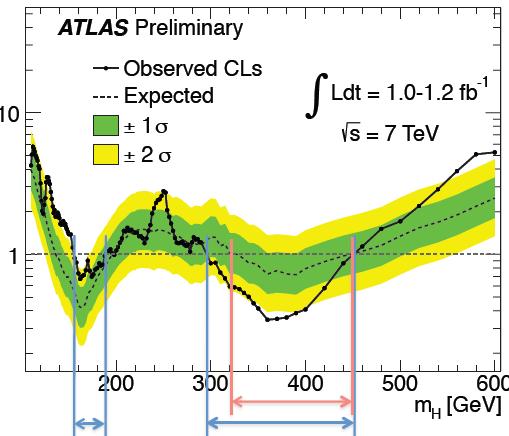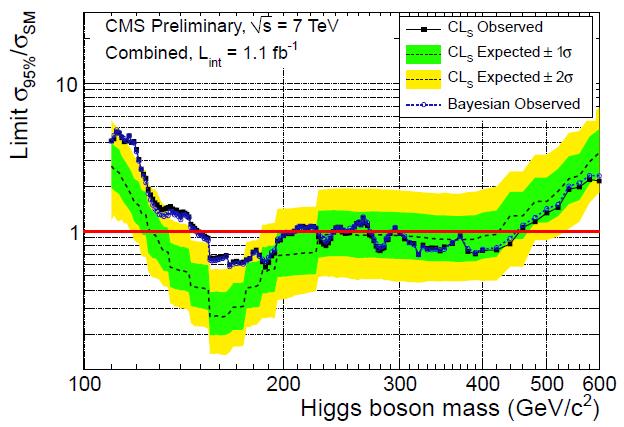The prompt reporting of these new results was not a totally painless activity on my side, because I am currently on vacation in southern Crete (you can have a look below at the beach where I spent most of the early afternoon today, Skinaria): my time these days is precious, and my connection with the experiment and with the rest of the world is granted by a internet USB stick by "Cosmote" which, despite working surprisingly well, still provides less bandwidth than I could use.
 I am thus the last in a small crowd of bloggers to comment on the recently produced "combined exclusion" results on the Standard Model Higgs boson. Having failed in promptness, and being seriously challenged in insight (most of all by Jester), I can only offer here my very own feelings on the results and their meaning. To guide my discussion, let me first of all paste here the ATLAS and CMS combined exclusion figures. The ATLAS plot is extracted from Kyle Cranmer's excellent talk at the EPS, so bear with me for the annoying extra coloured arrows.
I am thus the last in a small crowd of bloggers to comment on the recently produced "combined exclusion" results on the Standard Model Higgs boson. Having failed in promptness, and being seriously challenged in insight (most of all by Jester), I can only offer here my very own feelings on the results and their meaning. To guide my discussion, let me first of all paste here the ATLAS and CMS combined exclusion figures. The ATLAS plot is extracted from Kyle Cranmer's excellent talk at the EPS, so bear with me for the annoying extra coloured arrows.
ATLAS (above) and CMS (below) produced 95% C.L. upper limits employing the same limit-setting procedures, which imply a profile likelihood ratio as test statistics and the modified frequentist CL_s technique to extract results. CMS also tries the Bayesian procedure with flat cross section prior as an alternative, but we well know that this is almost coincident with CLs. In any case, these are details which I do not want to spend time on. The only important thing to note is that luckily ATLAS does not report their limits with their recently proposed "16% PCL" technique, which was effectively a patched up CL_sb technique which would make comparisons with other experiments results unnecessarily difficult.

Again, I need to advise you to visit the Resonaances site for a few very important points on the whole matter. I can only echo here the ones I find useful to stress, giving my own slant. However, the last one I think is not discussed elsewhere:
1) Significant portions of the high-mass region are now excluded by the two experiments; it does not take a computer brain to add two and two, and realize that even the smallish regions where CMS leaves hope that a Higgs boson might hide above 200 GeV would be excluded by a combination of the two LHC results. So the whole region between 145 and 450 GeV is not where a SM Higgs can hide from us. However, please keep in mind that if we "exclude at 95% CL" the existence of a Higgs boson with mass M(H)=x, this means really little in terms of the reality of things. That is, the Higgs might still have mass x and a negative background fluctuation there might have fooled us into excluding it. This happens once in twenty cases, which is really a not so rare occurrence: a 95% CL exclusion will never give you any certainty. Of course, the confidence level for some mass points is much, much higher than 95%; for 160 GeV, for instance, the Higgs is certainly ruled out, since the chance that we missed it there are really much smaller than 5%.
2) Implicit in the existence of the above figures, with black lines spending a significant portion of their free time below 1.0, is the fact that the Tevatron is now out of business on Higgs limit setting, with one important exception. The only region where they could still have anything meaningful to say with their full 10/fb datasets is in the whereabouts of 115 GeV, which is however a very important mass point. In the meantime, the data that the LHC will provide before the end of 2011 - four times as much data as the one used for the graphs you see above- will make these conclusions even stronger.
3) Some of the most sensation-seeking physicists in my experiment and in its competitor have already started to speculate that the 140 GeV mass point could be the place where the Higgs boson actually hides: both ATLAS and CMS have more Higgs candidates there than they expect from background sources alone, and both quote local significances in excess of two standard deviations for that mass. Let me be a sceptic this time again: I do not see these results as anything compelling in this respect. Of course if the Higgs has a mass above 115 and below 145 GeV, 140 GeV is a good place to put your money on -chances are better than one in ten it is there, and given the data shown above probably a more honest payoff would be three-to-one. In any case, if the mass is 140 GeV we will probably have a discovery by the end of the year!
4) I think the most important thing to draw home from the above results is their very existence. You might have overlooked this fact, but please consider that some of the data used to produce the graphs (and the hundreds of ancillary figures that belong to the individual searches summarized in those graphs) have been produced just one month ago! This is unheard-of in hadron collider physics experiments, and you should compare it with the Tevatron, where the most up-to-date results use data which are six months old or more -a time where the LHC still had to start the 2011 running... Such a display of power and focus on results is real news, and quite remarkable in my humble opinion. Not only were the data processed and calibrated in no time; they were also validated and analyzed basically overnight. Plus the internal groups and review committees have really worked around the clock to make the deadline of EPS.
5) Connected with the former observation is a sad note for a researcher who would like to think he has a life -yes, me. The rush with which the data is produced, reconstructed, and analyzed makes everybody unhappy -actually, nobody even realizes it because nobody even has the time to stop and think about it. It is a continuous frenzy of meetings, requests for additional checks, new data pouring in, jobs being sent around the world on a thousand computers at a time. Is this the life of a physicist in the 21st century ? If so, maybe I should consider focusing on teaching!
6) Thanks for your interest in Higgs boson searches - if you got this down the article, you give me a reason to continue reporting on it.




Comments